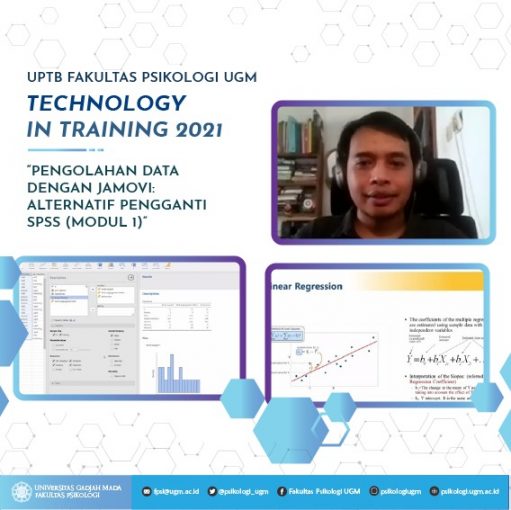
Some people may use SPSS more often for data processing, even though besides SPSS there are other data processing applications that can be used. One such application is JAMOVI and on Friday (5/3), the Learning Technology Development Unit (UPTB) held a Technology in Training event: “Data Processing with JAMOVI, an Alternative to SPSS” to introduce JAMOVI to academics, especially students. The event was filled by Wahyu Jati Anggoro, S.Psi., M.A. and starting at 13.00 to 15.00.
Wahyu started this program by first explaining statistics. There are three things that are a function of statistics, namely organizing, summarizing, and interpreting data. “The basic function of statistics, both descriptive and inferential, is actually speaking at the sample level,” said Wahyu. Then, if the discussion is reduced, the quantitative data consists of discreate variables, such as gender, demographic data, and so on, while continuous variables are in the form of a psychological scale or psychological test.
“JAMOVI is actually the answer to a number of worries, if we talk about data analysis we use SPSS. Usually, SPSS features a lot, but also SPSS software, which is quite expensive,” said Wahyu. In JAMOVI, there are two windows, the left is for data display, while the right is for the output of data. This is different from SPSS, which displays the output data with a separate window in the form of a pop-up. Then, when the output file and the original data file are saved, JAMOVI will save them in the same file. This is also the difference between JAMOVI and SPSS which store the output file and the original data file separately.
Before entering the data into JAMOVI, Wahyu suggested arranging the data in an excel file to make it easier for users to process data in JAMOVI. “Even though JAMOVI can actually import data directly from excel,” said Wahyu. Furthermore, the data that has been organized into an excel file is saved in the form of .jsv so that it can be directly called into JAMOVI. “Because .jsv is more fluid, it’s easier to check,” said Wahyu. Then, the explanation was continued by introducing the menu features owned by JAMOVI and direct practice of processing data using JAMOVI.
At the end of the event, Wahyu reminded the participants for the next meeting to bring their final project data so that they can be discussed together. This was done in connection with the agenda of the next meeting which discussed general linear models, such as ANOVA and moderation. This agenda was indeed held by UPTB for two days, namely on March 5, 2021 and March 12, 2021. The hope is that the events scheduled for the UPTB related to JAMOVI can help, especially students who are currently working on their final projects, like a thesis.
